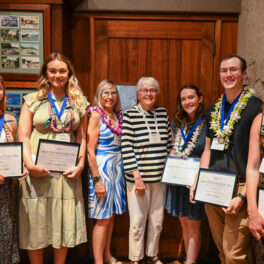Dr. Eleanor Sterling, Jaffe Chief Conservation Scientist at the American Museum of Natural History’s Center for Biodiversity and Conservation, has been selected as a finalist for the position of director of the Hawai‘i Institute of Marine Biology (HIMB) in the School of Ocean and Earth Science and Technology at the University of Hawai‘i (UH) at Mānoa.
Sterling will visit the UH campus for a two-day interview that will include meetings with faculty, staff, students, post-doctoral researchers and members of the UH Mānoa and HIMB communities as well as two presentations. Campus and community members, and the general public, are encouraged to attend the public presentations, as they will be available via Zoom links.
Dr. Eleanor Sterling’s talks have been scheduled as follows:
April 26, 2021, 10:00 – 11:00 am
“Strategic Directions for HIMB”
Large Pauley Classroom, HIMB
Zoom Link: https://us02web.zoom.us/j/83253227200?pwd=cXc0c084YnpFSHFpSkR4ZVlaUTNPUT09
Meeting ID: 832 5322 7200
Passcode: 613939
April 27, 2021, 11 am – 12:00 pm
“HIMB: A global vision for the future”
POST 723, UH Mānoa campus
Zoom Link: https://us02web.zoom.us/j/85772577402?pwd=OFpHY0tDa1BUTFVzcXgwTWZXVURlQT09
Meeting ID: 857 7257 7402
Passcode: 121066
“Dr. Sterling is a world-class scholar, and we are thrilled that she might become our next director,” said Dave Karl, oceanography professor in SOEST and chair of the search committee for the HIMB director position.
More about Dr. Eleanor Sterling
Building on her interdisciplinary training and over 30 years of field research and community collaboration experience in Oceania, Africa, Asia, and Latin America, Sterling’s work focuses on systems approaches to conservation and natural resource management; food systems; the intersection between biodiversity, culture, and languages; the factors influencing ecological and social resilience; and the development of indicators of multidimensional well-being. She is an expert in strategic planning from a systems perspective and in implementation and evaluation of capacity development. She undertakes research in the classroom to improve teaching and learning.
She is a behavioral ecologist and endangered species biologist, having co-led sea turtle research on Palmyra Atoll and humpback whale research in Madagascar. She is a world authority on the aye-aye, a nocturnal lemur endemic to Madagascar. She collaborates on an initiative integrating biology and econometrics across multiple scales for sustainable wildlife trade in Vietnam. She served as the Executive Chair of the Palmyra Atoll Research Consortium for six years. She is currently Deputy Vice Chair for the International Union for the Conservation of Nature’s (IUCN) World Commission on Protected Areas Core Capacity Development group where she co-leads working groups on Indigenous Peoples and Local Communities and on Capacity Development Evaluation. She co-founded the Equity, Inclusion, and Diversity Committee of the Society for Conservation Biology and the Women in Natural Sciences New York chapter of the Association for Women in Science.
Dr. Sterling is currently a core affiliate professor at Columbia University, where she served as Director of Graduate Studies for the Department of Ecology, Evolution, and Environmental Biology for ten years. She teaches graduate and undergraduate students at Columbia University and the American Museum of Natural History on remote sensing and GIS for conservation, food systems, biocultural diversity, and conservation biology.
She received her B.A. degree from Yale College, and M.Phil. and a dual Ph.D. degree in Anthropology and Forestry and Environmental Studies from Yale University. In 2012 she earned Columbia University’s Faculty Mentoring Award and in 2013 the Society for Conservation Biology’s Distinguished Service Award forteaching, mentoring, and research. In 2016 she received the Meritorious Research Award from IUCN’s Commission on Environmental, Economic, and Social Policy, and also the prestigious Wilbur Lucius Cross Medal from Yale University, the highest honor for Yale Graduate Student alums, for distinguished achievements in scholarship, teaching, and public service. In 2017, she was honored with the Women in Science at Yale (WISAY) Distinguished Woman Scientist Award. In 2018, she received a Distinguished Alumni Award from the Yale School of Forestry & Environmental Studies, an Honorary Doctor of Science degree from The State University of New York College of Environmental Science and Forestry (SUNY ESF), and a WINGS World Quest 2018 Women of Discovery Humanity Award.
For further information, contact Dave Karl at dkarl@hawaii.edu.












